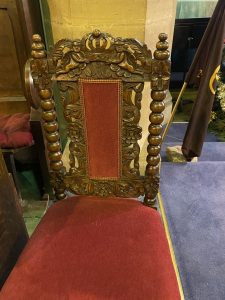I went to Swanwick first thing on the Thursday before Christmas to take a funeral. It was a very foggy day (when we were in the cemetery it was like something out of Dickens).
I went back before the New Year to get some outside photos – and it rained. The church is by the crossroads in the middle of the town – SK 405531. Parking not easy for a funeral.
The church was built between 1858 and 1860 by Benjamin Wilson – he was a Derby architect who also built Ashbourne Town Hall and St Giles Matlock. Swanwick is first mentioned in a charter of 1275, and a coal mine was established here as early as 1368. Much of the land belonged to a nearby monastery, at the Dissolution the Babingtons of Dethick took it over. By 1620 it was owned by the Turner family, whose house was where The Hayes conference centre is now. (I don’t like clergy conferences, so a day or two at The Hayes always depresses me!). The village was beginning to spread from here up to the present centre where the church is now.
In 1736 the Swanwick Colliery Company was established, a bit further north (by the services by the A38). The village also became renowned for its silk stocking cottage industry which went on to supply the Royal Family during the time of Queen Victoria. The domestic framework knitting industry continued into the C20. Footware was also manufactured here – apparently there is still a Boot and Slipper pub. In the late C18 the Butterley Iron Company was built just south of the village and the industrial development of the area continued. The colliery closed in 1968 and this is not a pretty (or affluent) area of Derbyshire.
The land for the church was given by Rev John Wood. Much of the money came from Fitzherbert Wright, the chap who was Managing Director of the Butterley works. In 1902 he gave the money for the tower to be added – this was designed by the firm of Naylor, Sale and Woore. “Nisi Dom” is “Except the Lord … build the house, their labour is but lost that build it” (Psalm 127 verse 1) – of course the miners of Swanwick would get that reference immediately (as did a C21 Vicar – he lied (and I had google)). Pevsner did not like the carvings. I did, and I like the men and women on the window carvings of the church itself.
Inside the church is large and high – we had about 40 people for the funeral, it would have been dismal if there had been less. They have taken some pews out and use the space wisely.
The east window is by Martin Travers, dated 1922 – according to Wikipedia he was “one of the most influential British stained glass artists of the twentieth century.” He was based in Fulham, and there is a selection of his images on the V&A website. The most recent book about him retails at £55, which is a bit outside my price range! Christ in Majesty.
The west window shows the calling of St Andrew and is dated 1953. There is a children’s window too, but her toy is not one we would portray today.
Lovely fish on the altar frontal.
The Nativity triptych is signed F.P., an Italian POW at The Hayes – rather lovely. I was told the faces were modelled on fellow prisoners.
Rather a lovely chair, and even the eagle was being festive.

















